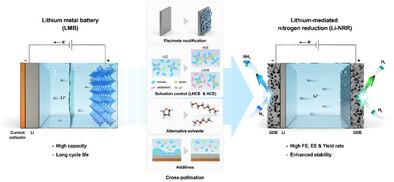Advancing Lithium-Mediated Nitrogen Reduction using Insights from Lithium-Ion Battery: Focusing on Uniform Li Plating
IF 26
1区 材料科学
Q1 CHEMISTRY, PHYSICAL
引用次数: 0
Abstract
Lithium-mediated nitrogen reduction reaction (Li-NRR) offers a promising alternative to the energy-intensive Haber–Bosch process for ammonia (NH3) synthesis, enabling renewable-powered NH3 production. However, this technology faces multiple challenges in terms of Faradaic efficiency (FE), energy efficiency (EE), stability and scalability. These problems arise from a variety of causes, but they have one thing in common: they can be improved by uniform deposition of lithium (Li). Therefore, promoting uniform Li plating could serve as a key breakthrough in addressing these issues. This review highlights various studies focusing on the issues associated with Li-NRR and proposes ideas based on previously reported research on Li metal battery (LMB) systems, which exhibit similarities with the Li-NRR systems with respect to Li plating and the formation of a solid-electrolyte interphase (SEI). Effective cross-pollination of various methods, including electrode modifications, solvation control of Li+, and application of additives, are introduced. Elaboration of correspondences between Li-NRR and LMB systems suggests an efficient research strategy for advancing the Li-NRR field. This review underscores the synergistic potential of hybrid strategies for addressing the critical challenges related to Li-NRR and provides future research directions and possibilities in this field, which would eventually accelerate progress toward sustainable green NH3 production.

利用锂离子电池的见解推进锂介导的氮还原:专注于均匀的锂电镀
锂介导的氮还原反应(Li-NRR)为氨(NH3)合成的高能耗Haber-Bosch工艺提供了一个有希望的替代方案,实现了可再生动力的NH3生产。然而,该技术在法拉第效率(FE)、能源效率(EE)、稳定性和可扩展性方面面临多重挑战。这些问题是由各种各样的原因引起的,但它们有一个共同点:它们可以通过均匀沉积锂(Li)来改善。因此,促进均匀镀锂可能是解决这些问题的关键突破。本文重点介绍了与Li- nrr相关的各种研究,并根据先前报道的锂金属电池(LMB)系统的研究提出了一些想法,这些研究在镀锂和形成固-电解质间相(SEI)方面与Li- nrr系统有相似之处。介绍了各种有效的异花授粉方法,包括电极修饰、Li+的溶剂化控制和添加剂的应用。阐述Li-NRR与LMB系统之间的对应关系,为推进Li-NRR领域的研究提供了有效的策略。这篇综述强调了混合策略在解决Li-NRR相关关键挑战方面的协同潜力,并提供了该领域未来的研究方向和可能性,最终将加速可持续绿色NH3生产的进程。
本文章由计算机程序翻译,如有差异,请以英文原文为准。
求助全文
约1分钟内获得全文
求助全文
来源期刊

Advanced Energy Materials
CHEMISTRY, PHYSICAL-ENERGY & FUELS
CiteScore
41.90
自引率
4.00%
发文量
889
审稿时长
1.4 months
期刊介绍:
Established in 2011, Advanced Energy Materials is an international, interdisciplinary, English-language journal that focuses on materials used in energy harvesting, conversion, and storage. It is regarded as a top-quality journal alongside Advanced Materials, Advanced Functional Materials, and Small.
With a 2022 Impact Factor of 27.8, Advanced Energy Materials is considered a prime source for the best energy-related research. The journal covers a wide range of topics in energy-related research, including organic and inorganic photovoltaics, batteries and supercapacitors, fuel cells, hydrogen generation and storage, thermoelectrics, water splitting and photocatalysis, solar fuels and thermosolar power, magnetocalorics, and piezoelectronics.
The readership of Advanced Energy Materials includes materials scientists, chemists, physicists, and engineers in both academia and industry. The journal is indexed in various databases and collections, such as Advanced Technologies & Aerospace Database, FIZ Karlsruhe, INSPEC (IET), Science Citation Index Expanded, Technology Collection, and Web of Science, among others.
 求助内容:
求助内容: 应助结果提醒方式:
应助结果提醒方式:


